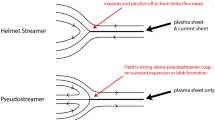Abstract
Radio pulsars have long been established as having high velocities that are probably produced in the violence of their formation in Supernovae (Gunn & Ostriker 1970; Lyne, Anderson & Salter 1982). Three recent developments have resulted in a reassessment of their velocities: the adoption of a new distance scale (Taylor & Cordes 1993), many new determinations of proper motion (Harrison, Lyne & Anderson 1993; Bailes et al. 1989; Fomalont et al. 1992) and the realisation (Harrison & Lyne 1993) that estimates of speeds derived from scintillation measurements were systematically low by about a factor of 2. Taking into account a strong selection effect that makes the observed velocities unrepresentative of those acquired at birth, it seems that the mean space velocity of pulsars at birth is 450 ± 90 km s-1 (Lyne and Lorimer 1994), about a factor of 3 greater than earlier estimates. The general migration from the Galactic plane is consistent with birth in the supernova of massive Population I stars. An outstanding question is how such velocities are produced in the kinetics of supernova collapse. This large increase in birth velocity is likely to have a major impact upon our understanding of the retention of neutron stars in binary systems, globular clusters and the Galaxy as it exceeds or is comparable with all their escape velocities. The rapid spatial separation of fast and slow pulsars will have a profound effect upon calculations of the galactic population and birth rate, both of which have been underestimated in the past. Furthermore, the distribution of dead neutron stars will be more isotropic and may better match the distribution of the gamma-ray burst sources. A small number of pulsars are at a large distance from the Galactic plane, but moving towards it. The most likely origin of these objects lies in OB runaway stars.
Similar content being viewed by others
References
Bailes M., Manchester R. N., Kesteven M. J., Norris R. P., Reynolds J. E., 1989, ApJ, 343, L53
Bailes M., 1989, ApJ, 342, 917
Bailyn C. D., Grindlay J. E., 1990, ApJ, 353, 159
Bell J. F., Bailes M., Manchester R. N., Weisberg J. M., Lyne A. G., 1994, submitted to Ap. J.
Bhattacharya D., van den Heuvel E. P. J., 1991, Phys.Rep., 203, 1
Bhattacharya D., Wijers R. A. M. J., Hartman J. W., Verbunt F., 1992, AA, 254, 198
Blaes O., Madau P., 1993, ApJ, 403, 690
Caraveo P. A., 1993, ApJ, 415, L 111
Cordes J. M., 1986, ApJ, 311, 183
Dewey R. J., Cordes J. M., 1987, ApJ, 321, 780
Fomalont E. B., Goss W. M., Lyne A. G., Manchester R. N., Justtanont K., 1992, MNRAS, 258, 497
Frei Z., Huang X., Paczynski B., 1992, ApJ, 384, 105
Fruchter A. S., Taylor J. H., Backer D. C., Clifton T. R., Wolszczan A., 1988, Nat, 331, 53
Galt J. A., Lyne A. G., 1972, MNRAS, 158, 281
Gunn J. E., Ostriker J. P., 1970, ApJ, 160, 979
Harrison P. A., Lyne A. G., 1993, MNRAS, 265, 778
Harrison P. A., Lyne A. G., Anderson B., 1993, MNRAS, 261, 113
Hartmann D., Epstein R. I., Woosley S. E., 1990, ApJ, 3. 48, 625
Kaspi V. M., Taylor J. H., Ryba M., 1994, ApJ, 428, 713
Li H., Dermer C. D., 1992, Nat, 359, 514
Lorimer D. R., Baues M., Dewey R. J., Harrison P. A., 1993, MNRAS, 263, 403
Lorimer D. R., 1995, MNRAS, in press
Lyne A. G., Lorimer D. R., 1994, Nat, 369, 127
Lyne A. G., Smith F. G., 1982, Nat, 298, 825
Lyne A. G., Anderson B., Salter M. J., 1982, MNRAS, 201, 503
Meegan C. A., Fishman G. J., Wilson R. B., Paciesas W. S., Pendleton G. N., Horack J. M., Brock M. N., Kouveliotou C., 1992, Nat, 355, 143
Narayan R., Ostriker J. P., 1990, ApJ, 352, 222
Nicastro L., Johnston S., 1995, MNRAS, in press
Nice D. J., Taylor J. H., 1995, ApJ, in press
Paczynski B., 1990, ApJ, 348, 485
Rickett B. J., 1970, MNRAS, 150, 67
Scheuer P. A. G., 1968, Nat, 218, 920
Slee O., Ables J. G., Batchelor R. A., Krishna-Mohan S., Venugopal V. R., Swarup G., 1974, MNRAS, 167, 31
Taylor J. H., Cordes J. M., 1993, ApJ, 411, 674
Author information
Authors and Affiliations
Rights and permissions
About this article
Cite this article
Lyne, A.G., Lorimer, D.R. Pulsar velocities. J Astrophys Astron 16, 97–106 (1995). https://doi.org/10.1007/BF02714827
Issue Date:
DOI: https://doi.org/10.1007/BF02714827




